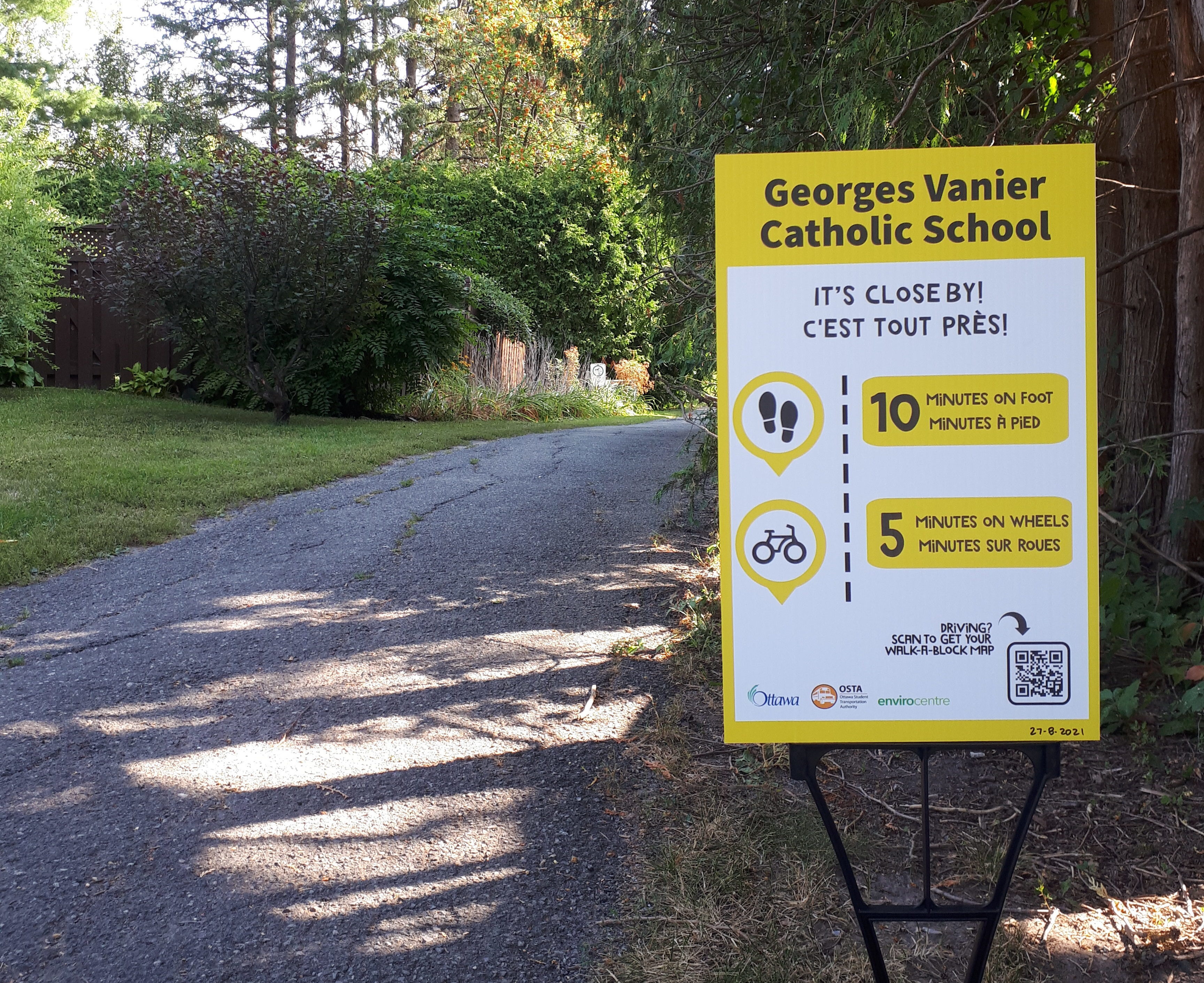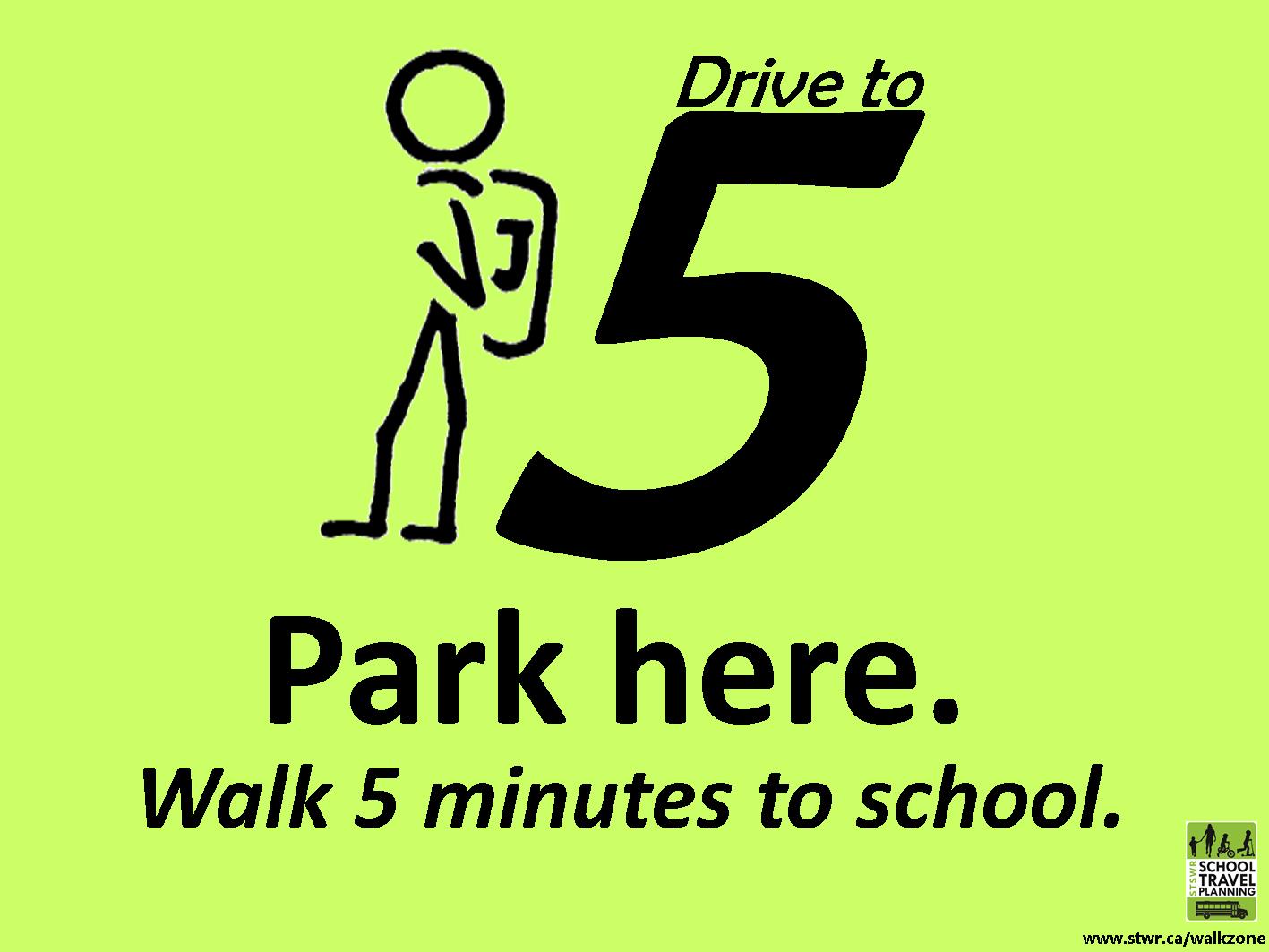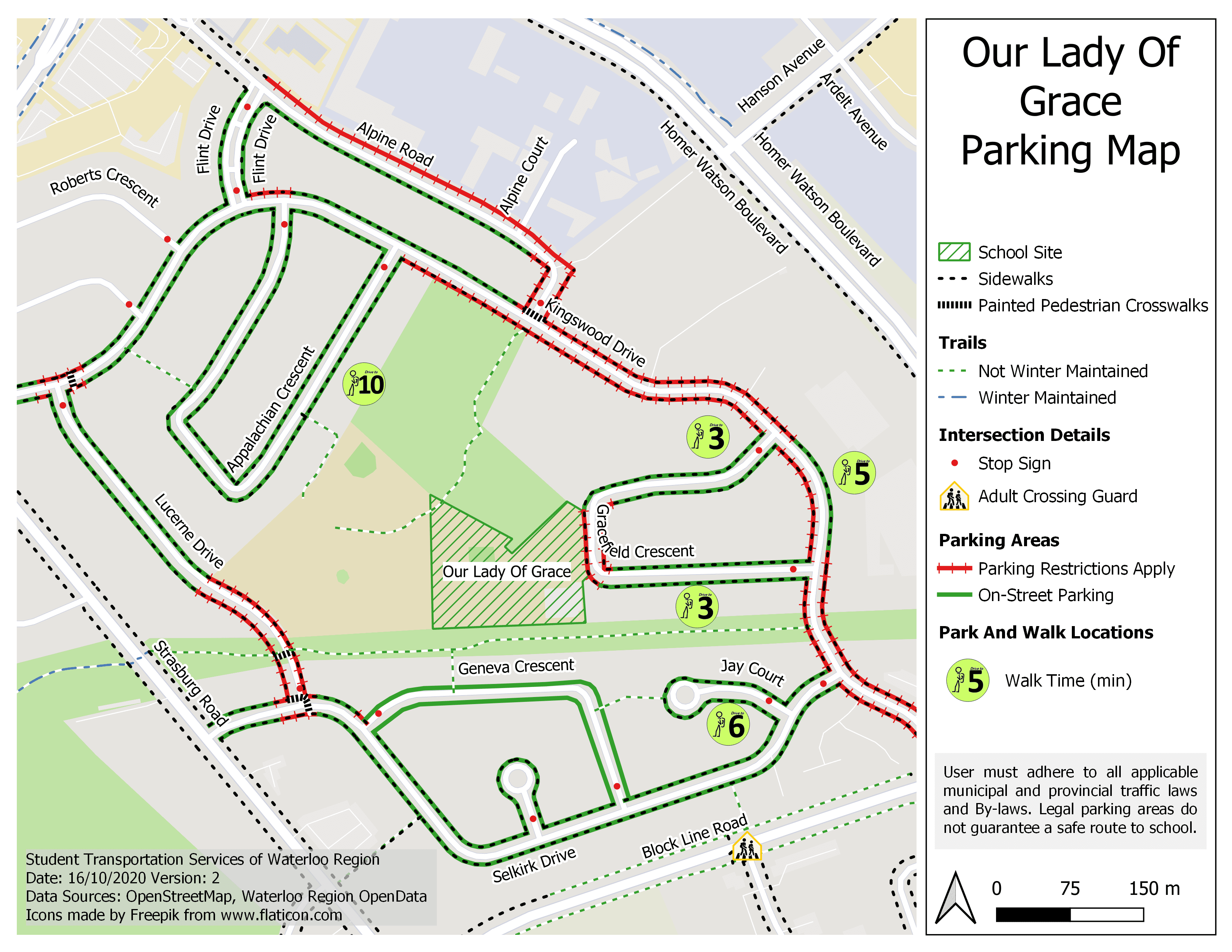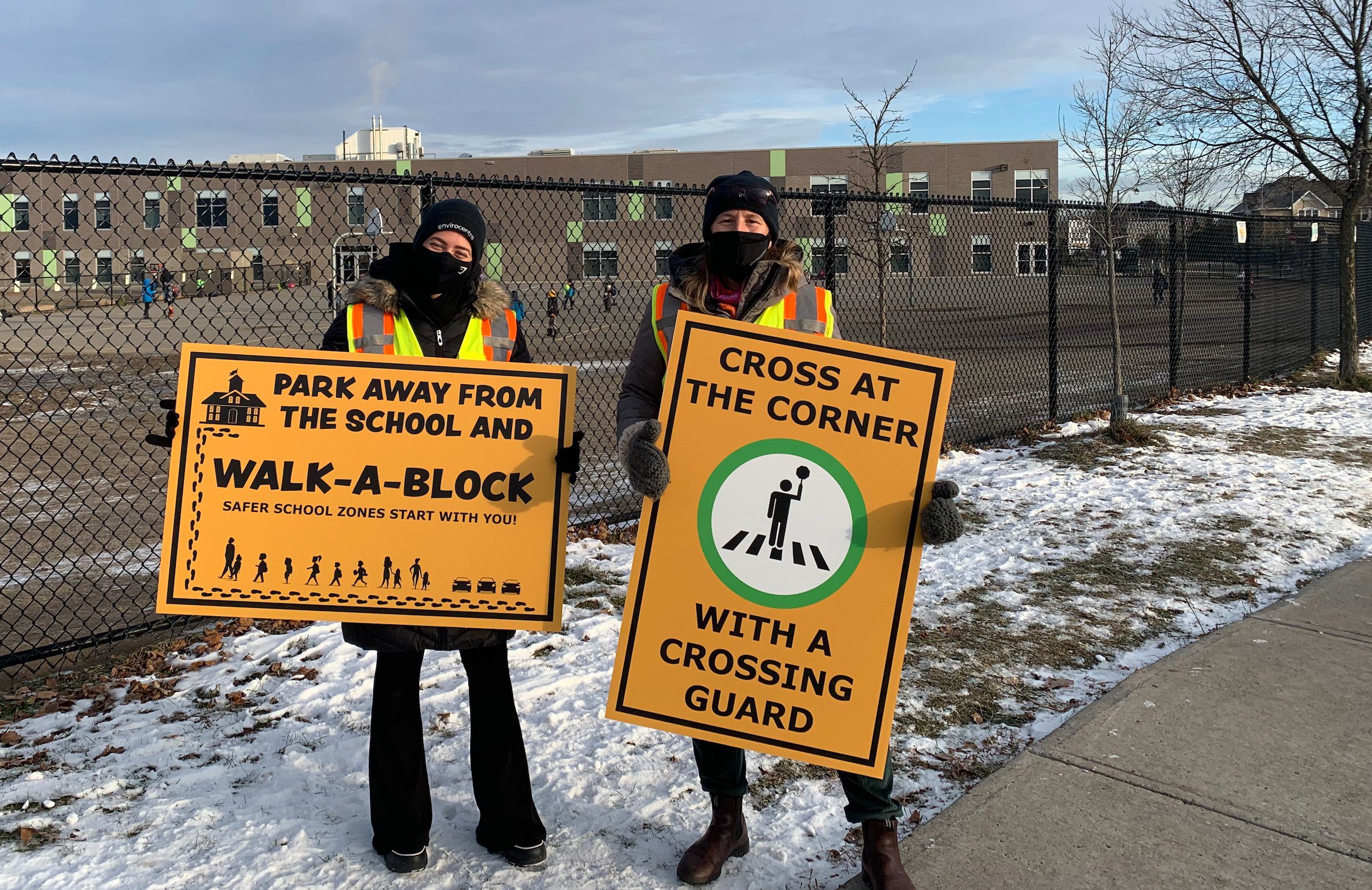Ottawa Student Transportation Authority (OSTA) and EnviroCentre’s ‘Walk a Block’ signs (photo by EnviroCentre via Twitter)
Many parents and caregivers must drive their children to school because of far distances, mobility challenges, and/or other barriers. However, when too many people drive to school, school zones can become chaotic and have an increased risk of traffic violations and collisions with young pedestrians and cyclists. Additionally, vehicles idling in the school zone, often waiting in a long line for drop-off and pick-up, contribute to greenhouse gas emissions and air pollution that harms young lungs.
So, if some people must drive but too many vehicles in the school zone can cause serious harm, is there a way to address this school zone chaos?
Consider trying ‘Drive to 5’ – also known as ‘Park & Stride’, ‘Park & Walk’ or ‘Walk a Block’ at your school!
Drive to Five
The Drive to 5 initiative simply encourages parents/guardians who must drive their kids to school to park outside of the school zone and walk the last five minutes, either together or independently.
Drive to 5 is a low-barrier program with many benefits, such as:
- Alleviating traffic congestion
- Improving road safety
- Encouraging active school travel
- Providing physical activity to jumpstart learning
- Improving air quality
- Saving time for parents/guardians
- Helping children gain independence
- Providing the opportunity for families to walk together
Starting a program
Implementing a Drive to 5 program typically involves creating designated school drop-off and pick-up locations within a five-minute walk to the school, along with a campaign targeting parents and guardians who drive to school. Successful programs generally have multiple designated parking locations, broad community support, and engagement with key participants, which can all be customized to suit a school’s needs and available resources.
Choosing parking locations
Schools should choose one or more parking or drop-off locations that are within a 5-minute walk along a safe route to school. Potential locations include on-street parking, a recreation centre parking lot, or a neighbourhood park.
It is especially recommended (based on item B.4.3 in the evidence-based policy recommendations report prepared by Green Communities Canada and the Healthy Environments Analysis Lab) that schools and municipalities collaborate in the implementation of these programs. Collaboration is particularly important to help identify suitable locations that do not interfere with waste collection, emergency response, and other municipal services.
Once the locations are determined, schools can create maps that show Drive to 5 locations, sidewalks, crossing guards, bike paths, bicycle parking, wheelchair ramps, and more markers for active and safe routes to school. When creating these maps, there should be consideration for ever-evolving road restrictions, creating symbols that work across multiple formats, and accommodating people with low or different vision (e.g., colour blindness).
Schools should also consider marking the locations, using paint or eye-catching street signs, so that they are highly visible for drivers. Wayfinding signage can also be used to help encourage uptake and lead walkers in the right direction. This includes using sidewalk stencils (e.g., footprints, animal prints, arrows, etc.) and signs that provide estimated active travel distances (e.g., 7-minute walk, 3-minute wheel, etc.).  Ottawa Student Transportation Authority (OSTA) and EnviroCentre’s Wayfinding signs outside of Georges Vanier Catholic School (photo by EnviroCentre)
Ottawa Student Transportation Authority (OSTA) and EnviroCentre’s Wayfinding signs outside of Georges Vanier Catholic School (photo by EnviroCentre)
Gaining community buy-in
Almost anyone can help initiate a Drive to 5 program, from the school principal, parents and other community members, to municipal transportation staff. Whoever the initiators may be, it is often helpful if they can seek out a “champion” who can help to build consensus and gain momentum within the community. Champions could be a school administrator, teacher, parent, guardian, or elected official.
Schools can also gain community support by engaging stakeholders, such as parents and neighbours, to ask for their input on parking locations and the development of route maps. Additionally, schools can engage their head secretary and other administrators who frequently interact with parents and community members so that they can help raise awareness for the initiative and provide support for those using the drop-off locations.
If additional support and capacity is needed, we recommend engaging community partners such as the school board, transportation consortium, public health unit, the school travel planning facilitator, a local non-profit, or any organization supporting active school travel in your area.  Drive to 5 Parking Sign example from STSWR
Drive to 5 Parking Sign example from STSWR
Promoting the program
To get people doing Drive to 5, they need to know about it first! Promotions play a key role in shaping school travel behaviour. For example, when the Ottawa Student Transportation Authority collected data on their park and walk program (a.k.a Drive to 5), they noticed that promoting the program led to increased usage rates, whereas, in the absence of promotions, walk-a-block usage rates decreased.
Promotional approaches should target desired participants: students, parents/caregivers, and community members. For example, approaches targeting students include holding assemblies, making announcements, and putting up posters, all of which can help get students excited and encourage their parents/caregivers to use ‘Drive to 5’ locations.
To engage families, it may be effective to have the principal and/or parent advisory council communicate with families (via email and/or pamphlet) about using the designated parking locations (use the templates prepared by STSWR and the sample emails prepared by CRD). Schools can distribute Drive to 5 maps at walk and wheel events or hold a sidewalk “blitz” to share printed versions with parents and caregivers parked near the school. Additionally, putting up signs in the area can let community members know that a street is a designated school route, that drivers should slow down, or that there are opportunities to volunteer with the initiative.
 Parking Map example from Our Lady of Grace (prepared by STSWR)
Parking Map example from Our Lady of Grace (prepared by STSWR)
Growing the program
If the small-scale Drive to 5 initiative is going well, consider growing it! There is always plenty of room to do more, for instance by leading awareness campaigns, creating wayfinding signs, developing walk zone maps, assigning walking leaders (or even a walking school bus!), or by providing rewards for students/families upon arrival. Awareness campaigns and events can be oriented around special occasions, such as the International Walk to School Day, Winter Walk Day, or Earth Day; similarly, they could be coordinated for weekly campaigns like ‘Walking Wednesdays’ or ‘Drive to 5 Fridays’.
To gain wider support for the program, consider collecting data on school transportation modes, usage of the ‘Drive to 5’ locations, and air quality surrounding the school. Having evidence to be able to demonstrate the program’s success can help justify expansion!
Programs in action
Successful Drive to 5 programs can be found across the province. For example, there is one in the Waterloo region, where Student Transportation Services of Waterloo Region (STSWR) has developed walk zone maps and a Drive to 5 planning guide. In Ottawa, the Ottawa Student Transportation Authority and EnviroCentre have coordinated Drive to 5 initiatives, complete with greeters and walk-a-block signs. Further, the York Region District School Board (YRDSB) encourages Drive to 5 as part of their ‘Walking Wednesday’s’ event.
Drive to 5 is just one of 57 policy recommendations to support healthier modes of school travel. To learn about the 56 other recommendations we invite you to read the ‘Investigation of Supportive Policy for Active School Travel’ report.
Special thank you to Leslie Maxwell, School Travel Planning Supervisor at Student Transportation Services of Waterloo Region, and Lisa Gander, Project Lead at EnviroCentre for sharing their experience and recommendations for implementing Drive to 5 programs.
Resources
https://schooltravel.ca/activity/drive-to-5/
https://www.stswr.ca/walkzone/maps/
https://www.stswr.ca/wp-content/uploads/Drive-to-Five-Planning-Guide.pdf
http://www.ottawaschoolbus.ca/helpful-resources/walking-route-walk-zone-maps-by-school/

